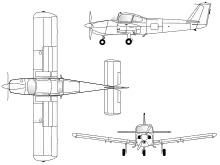Fuji FA-200 Aero Subaru
The Fuji FA-200 Aero Subaru is a single-engine piston-powered monoplane built by Fuji Heavy Industries of Japan.
| FA-200 Aero Subaru | |
|---|---|
 | |
| Fuji FA-200-160 | |
| Role | Civil light aircraft |
| Manufacturer | Fuji |
| First flight | 12 August 1965 |
| Introduction | 1968 |
| Produced | 1968–1986 |
| Number built | 275 |
_01.jpg.webp)
Fuji FA-200-180
Design and development
Fuji Heavy Industries began development of a four-seat light aeroplane, the Fuji FA-200 Aero Subaru in 1964, the first prototype flying on 12 August 1965.[1] It is a low-wing all-metal aircraft, fitted with a fixed nosewheel undercarriage and a sliding canopy. It was first certified in Japan on 6 July 1966, with certification in the United States occurring on 26 September 1967.[1]
Production started in March 1968, continuing until 1986, with a total of 275 built.[2]
Variants
- F-200-II
- Prototype with a 120 kW (160 hp) Lycoming O-320 engine
- FA-200-160
- Initial version, powered by 120 kW Lycoming O-320 engine and fixed-pitch propeller.
- FA-200-180
- More powerful development - 130 kW (180 hp) Lycoming IO-360 engine and constant speed propeller.
- FA-200-180AO
- Powered by 130 kW Lycoming IO-320 engine and fitted with fixed-pitch propeller.
- FA-203-S
- Experimental short takeoff and landing (STOL) version, developed by Japan's National Aerospace Laboratory fitted with boundary layer control system.
- F-201
- Proposed three-seat variant, not built.
- F-202
- Proposed two-seat aerobatic variant, not built.
- F-203
- Proposed STOL variant.
- F-204
- Proposed crop spraying variant, not built.
Accidents and incidents
- On May 13, 2017, a Fuji FM 200-160 with tail number E7-AAS, crashed in Jasenica, near Mostar in Bosnia and Herzegovina, killing all 5 on board. Among them were 3 children.[3]
Specifications (FA-200-180)

Fuji FA-200
Data from Jane's All the World's Aircraft, 1976-1977 [1]
General characteristics
- Crew: 1/2
- Capacity: 2/3 passengers
- Length: 8.17 m (26 ft 10 in)
- Wingspan: 9.42 m (30 ft 11 in)
- Height: 2.59 m (8 ft 6 in)
- Wing area: 14.0 m2 (151 sq ft)
- Aspect ratio: 6.34:1
- Empty weight: 650 kg (1,433 lb)
- Max takeoff weight: 1,150 kg (2,535 lb)
- Fuel capacity: 204.5 L (54.0 US gal; 45.0 imp gal)
- Powerplant: 1 × Lycoming IO-360B1B four cylinder air-cooled horizontally-opposed piston engine, 130 kW (180 hp)
- Propellers: 2-bladed McCauley B2D34C53/74E-0 metal constant-speed propeller, 1.88 m (6 ft 2 in) diameter
Performance
- Maximum speed: 233 km/h (145 mph, 126 kn)
- Cruise speed: 167 km/h (104 mph, 90 kn) 55% power at 1,525 m (5,000 ft)
- Stall speed: 97 km/h (60 mph, 52 kn) flaps down
- Range: 1,343 km (834 mi, 725 nmi) ; 55% power at 2,300 m (7,500 ft) with no reserve (max fuel)
- Service ceiling: 4,200 m (13,700 ft)
- Rate of climb: 3.9 m/s (760 ft/min) at sea level
See also
References
- Taylor, John W. R., ed. (1976). Jane's all the World's Aircraft 1976-77. London: Jane's Yearbooks. pp. 120–121. ISBN 0-354-00538-3.
- Donald, David, ed. (1997). The Encyclopedia of World Aircraft. Aerospace Publishing. ISBN 1-85605-375-X.
- "Light plane crash in Bosnia leaves five dead". Business Insider. 13 May 2017.
External links
Wikimedia Commons has media related to Fuji FA-200 Aero Subaru.
- FUJI/FA-200 AERO SUBARU Archived 2014-07-17 at the Wayback Machine
This article is issued from Wikipedia. The text is licensed under Creative Commons - Attribution - Sharealike. Additional terms may apply for the media files.